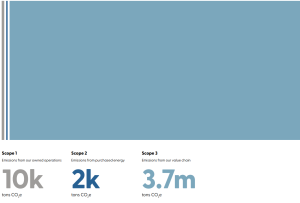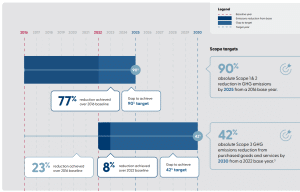Levi Strauss & Co. (Levi’s), a global leader in denim and lifestyle apparel, has released its first climate transition plan, aiming to achieve net zero emissions by 2050. It lays a roadmap to reach near-term greenhouse gas (GHG) reduction targets by 2030 and achieve longer-term climate goals.
Levi’s plan follows similar commitments made by brands like the H&M Group and Reformation, reflecting a growing trend in the fashion industry towards sustainable practices.
How Levi’s Plans to Achieve Net Zero
Levi’s 2050 net zero emissions goal involves both direct and indirect emissions throughout its entire value chain. This includes emissions from manufacturing processes, transportation, product usage, and end-of-life disposal.
- In 2023, the fashion firm’s total GHG emissions were over 3.7 million tons of CO2e. Of this, only 12 thousand tons of CO2e were Scope 1 and 2 emissions.

The company’s strategy is guided by the Science-Based Targets initiative (SBTi), ensuring that its climate action aligns with the Paris Agreement’s objective of limiting global warming to 1.5°C. It focuses on three areas to guide its climate actions.
-
Internal Operations and Scope 1 & 2 Emissions:
To reach its long-term goal, Levi Strauss has set specific interim targets for 2025.
The apparel giant is prioritizing a reduction in direct (scope 1) and energy-related (scope 2) emissions. This involves investing in energy-efficient technologies, and renewable energy, and implementing a global energy management system to guide strategic decisions.
By 2025, the company aims for a 90% reduction in these emissions, compared to its 2016 baseline as shown below. For Scope 3 emissions, which include the supply chain’s carbon footprint and product life cycle, the company targets a 40% reduction per product by 2025.

-
Engaging the Supply Chain to Tackle Scope 3 Emissions:
The second part of the strategy focuses on the broader value chain, tackling the significant impact of scope 3 emissions from global suppliers. Levi Strauss is working towards Science-Based Targets (SBT) by promoting sustainable materials, offering supplier financing for energy reduction efforts, and supporting circularity initiatives.
A key goal is to reduce scope 3 emissions related to apparel production by 42% by 2030, using a 2022 baseline. This target addresses 72% of the company’s total Scope 3 emissions, emphasizing a substantial focus on reducing indirect emissions across the value chain. These efforts include encouraging sustainable farming practices and enhancing transparency in supply chains.

Focusing on Scope 3 or value chain emissions is critical as they account for over 99% of the company’s total carbon footprint. The company’s goal is for 100% of its key suppliers to adopt renewable electricity by 2025.
-
Governance and Advocacy:
Levi’s aims to embed climate risks and opportunities into its overall business strategy to ensure strong governance throughout the transition. This includes regular updates on their progress through sustainability reports, ensuring accountability and alignment with international frameworks like the TCFD (Task Force on Climate-Related Financial Disclosures) and CDP (Carbon Disclosure Project).
According to Jeffrey Hogue, Chief Sustainability Officer at Levi’s, the climate transition plan is part of the company’s longstanding commitment to addressing climate change. He also noted that:
“These steps will not only move us toward our Net Zero climate ambition by 2050 but also strengthen our own business’s resilience to the effects of climate change.”
Renewables at the Core: Levi’s Push for 100% Green Energy by 2025
To reduce its Scope 1 and 2 emissions, Levi Strauss has committed to using renewable energy in its own operations. The company has already transitioned many of its facilities to renewable electricity and is actively investing in solar and wind power for its global offices and retail outlets.
Notably, it seeks to achieve 100% renewable electricity in all company-operated facilities by 2025. It also aims to reduce freshwater usage in water-stressed areas by 50% from a 2018 baseline by 2025. These targets align with global climate science and further the company’s broader sustainability goals.
Levi Strauss also recognizes the role of sustainable product design in achieving its net zero ambitions. The company focuses on extending the life of its products through durable design, using organic cotton, and reducing the use of water-intensive processes. Levi’s® WellThread™ collection, for example, incorporates circular design principles, making garments that are easier to recycle.
Leading the Industry Shift Towards Sustainability
Achieving net zero requires collective action, and Levi Strauss emphasizes engaging with stakeholders across its value chain. This includes not only suppliers but also consumers, employees, and investors. The denim company encourages consumers to adopt more sustainable behaviors, such as washing jeans less frequently and opting for cold water washes.
Levi Strauss has also joined industry coalitions like the Fashion Industry Charter for Climate Action, which unites fashion brands in taking bold actions to reduce carbon emissions. Through these partnerships, Levi’s aims to drive industry-wide changes and influence policies that support a transition to a low-carbon economy.
Since 2000, global fiber production has nearly doubled, rising from 58 million tonnes to 116 million tonnes in 2022. It is projected to reach 147 million tonnes by 2030 if current non-sustainable practices continue.
This industry growth comes with significant environmental costs. The fashion sector is the 2nd-largest water consumer and contributes 2%-8% of global carbon emissions. Without changing current practices, the industry’s share of the carbon budget will increase to 26% by 2050.
Additionally, 85% of textiles are dumped annually, and less than 1% is recycled.
The fashion company’s climate transition plan offers a promising path forward. By setting science-backed targets and engaging both internal and external partners, Levi Strauss. is taking concrete steps to reduce its environmental impact while inspiring others to help the fashion industry become more sustainable.

